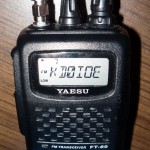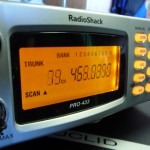In 2009, I applied for an Amateur Radio license from the Federal Communications Commission (FCC). I successfully passed the test(s) and received the call sign “KDØIOE”. This allows me to operate radios that can communicate all over the world. I personally prefer to talk on repeaters in local areas. These repeaters are used for general chit-chat, as well as in emergencies for coordinating information. I have always been interested in public safety radios and felt that this was a nice hobby to accompany that.
My Equipment
I own a few different radios, each of which I’ll describe below.
Yaesu FT-60R
This is my FT-60R, my first handheld radio. It has capacity for 1000 channels, and operates in both the 2 meter and 70 cm bands. It is a great little radio that I got a very good deal on at Radio City in Minneapolis. I don’t use it much anymore, but lately I’m thinking about getting in to Satellite, and it has a easier to use VFO than the Baofengs or the Wouxuns.
Yaesu FT-2600M
This was my first mobile/base radio. It has 170 channel capacity, and operates on the 2M band. It also forced me to buy an antenna (MFJ 1724B) and a power supply. The whole kit and kaboodle cost around $200 when all was said and done. I got the radio off eBay, also being my first eBay purchase. This radio has served me well, and I don’t plan on selling it anytime soon.
RadioShack PRO-433
While not a ham radio, this is just as useful. It is my 1000 channel police scanner. I use it to monitor the local repeaters, as well as listen to local public safety groups. Unfortunately, in my area, everything except one channel has switched over to APCO Project 25, and I’m not ready to shell out $500 for a new scanner to just hear that so I have to have a different scanner for that purpose. This one basically serves for paging and ham radio. Also makes a nice addition to my desk, providing some mellow amber color.
RadioShack Pro-106
Another scanner, traded in the VX-7RB to fund it. It is a full digital scanner, with trunk tracking and lots of channels and all sorts of goodies. I still use the above scanner, but this digital one provides a lot more listening. The drawbacks of a handheld scanner are the battery and the antenna. While I have an AC adapter, it charges the batteries at the same time, and tends to decrease the receive ability/sensitivity.
This radio is now semi-permanently set up with a Windows laptop to feed audio to my VoIP system and to the web via Icecast. I really only use it for personal listening, at work or at home. Additionally, I’ve found that this antenna works extremely well, even in my crappy first floor noisy (RF wise) apartment.
Wouxun KG-UV3D
This radio was purchased for the 2011 flood season. I volunteer with The Salvation Army’s Emergency Disaster Services team in Fargo, who has UHF business radios. This radio had the advantage of being able to transmit on both UHF business frequencies and dual-band amateur ones. I hope to make it my primary radio, once it proves its usefulness and battery life. 128 channels, “dual watch”, 5w/4w on VHF/UHF respectively. So far, it is my favorite non-big-brand radio.
Baofeng UV-5RA
Again, still reviewing. Check out here to see it.
I have two of these now, and they mainly are for projects or simple things. They can work on Salvation Army frequencies and ham in a pinch, but I mostly use them to listen or to do APRS via an Android phone.
Anytone AT-5888UV
Finally got a radio to mount in a vehicle. This $300 Chinese radio works extremely well for the price. It receives air band, which is enjoyable to listen to in the car when driving around town. In some cases you “get what you pay for” but as a radio that can do business band and amateur band, it is very convenient.


